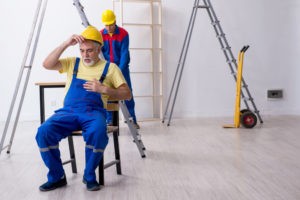
How negligence is proven in a construction accident case depends on what is required to hold the at-fault party liable. There are several regulations enforced to protect workers in construction and similar industries. These regulations set rules that employers, property owners, and general contractors must follow.
Under the Construction Standards from the Occupational Safety & Health Administration (OSHA), employers must ensure that those they hire have the required safety training, the right personal protective equipment for their job, and other resources to keep them safe. OSHA provides oversight and compliance for these standards, and workers who get hurt on the job generally qualify for workers’ compensation benefits regardless of fault.
In New York State, there are also statutes like the Scaffold Law. Under New York Labor Law § 240, landowners and general contractors must take additional steps to keep workers safe. When they do not, and a worker is hurt, they may be held strictly liable for the injuries that worker suffers.
Liability in a Scaffold Construction Accident
The Scaffold Law provides the most common path for construction workers to pursue third-party claims in New York State. This law calls for strict liability for landowners and general contractors.
Strict liability changes how negligence is proven in a construction accident case. When we seek damages in this type of case for our client, we do not have to prove the property owner and general contractor were negligent. We only need to show they failed to uphold their statutory duties and that the worker suffered job site injuries.
This and other related New York labor laws prevent those who have authority on construction sites from delegating their responsibility to keep workers safe. There is no option for ducking their responsibility, and they are directly accountable when a worker is hurt. This is true even if they did not know the workers were not using safety equipment, violating OSHA rules, or that there were other problems.
Understanding the Statutory Duties Under the Scaffold Law
The Scaffold Law applies to many types of construction workers who frequently use ladders and scaffolds or otherwise work at an elevated height. The most common incidents covered by this law include falls and falling debris or other objects.
The law puts several statutory duties in place, holding property owners and general contractors accountable for workers’ safety. This includes:
- Providing the proper equipment for the job, including ladders and scaffolding
- Ensuring all provided ladders and scaffolding are safe
- Providing personal protective equipment, including safety harnesses and lines
- Providing protection for workers from falling objects
- Ensuring all workers onsite follow the necessary safety protocols
When we handle one of these cases, we gather evidence to show that the landowner and/or general contractor failed to meet their statutory duties. We also need to prove our client’s related expenses and losses and put a fair settlement value on the case.
Valuing non-economic damages and future expenses often requires expert testimony. When necessary, we call on experts that include medical professionals, economists, vocational rehabilitation specialists, and life care planners in these cases.
Moving Forward with a Third-Party Construction Accident Case
When Friedman & Simon, L.L.P. represents an injured worker after a construction accident in New York State, we will do the following for our clients:
- Keep them updated throughout their case proceedings
- Identify the liable parties, such as who owns the property and the identity of the general contractor
- Speak on their behalf with all involved parties
- Collect the required proof to support their case
- Determine the value of their case
- Fight relentlessly to win the best possible outcome
Our team of passionate advocates for injured workers meets with people both on Long Island and elsewhere in the New York metropolitan area. We have team members who speak Bengali, Greek, Kannada, Spanish, and Tamil, if you are more comfortable discussing your injury in one of these languages.
Our team only has a limited time to file a lawsuit on your behalf if we need to do so. The state’s statute of limitations, New York Civil Practice Laws & Rules § 214, could bar you from taking legal action if you miss this deadline. This critical time limitation, together with practical considerations such as promptly trying to obtain evidence such as witness statements and job-site video footage, make it most wise to reach out for experienced construction accident legal representation as soon as you are able. The sooner you contact us, the greater our opportunity to build the strongest case possible on your behalf.
Friedman & Simon, L.L.P. represents workers injured on construction projects and similar sites in New York City, on Long Island, and other nearby areas. If you were hurt, we might be able to prove you qualify to hold the property owner or another liable party accountable in a third-party claim.
Discuss your case with our team now by dialing (516) 932-0400. A free case consultation is the first step to pursuing damages in your case.